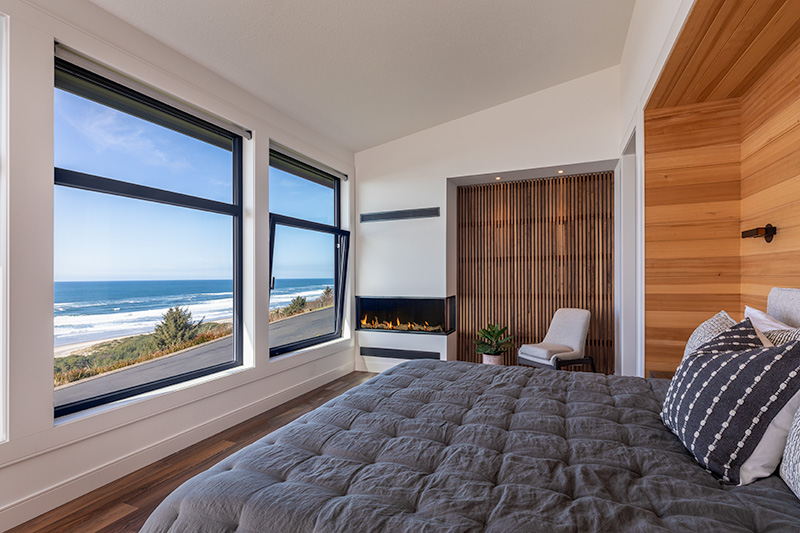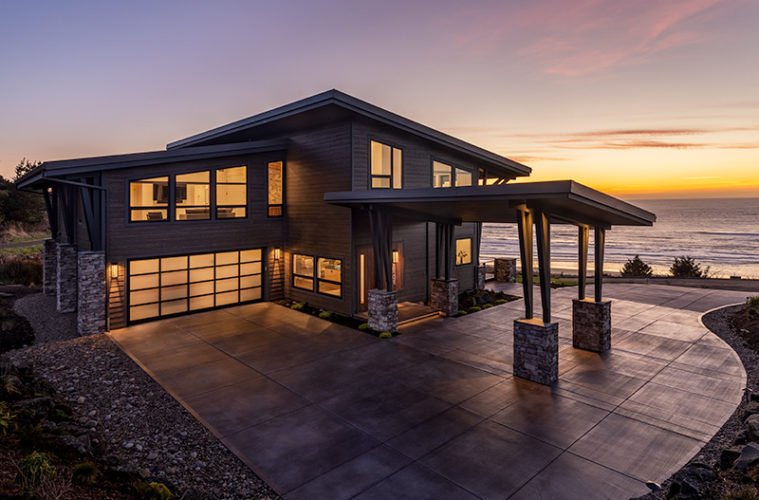It is often said that compromise is key to a good marriage. For these longtime homeowners on the Oregon coast, making concessions to each other not only made the design and construction of a new home relatively quibble-free, it also yielded a dynamic retreat inspired in part by the couple’s give-and-take approach. She wanted an ultra-modern house; he leaned toward a more traditional dwelling. They met approximately in the middle—a contemporary warmed up by the use of wood—and couldn’t be happier.








Listening intently to the couple’s ideas and incorporating some of them along with a slew of their own, architects Dustin and Amanda Capri approached the project with fervor. Lifetime Oregonians themselves, they embrace the unique Pacific Northwest environment and attempt to express its vicissitudes in their architecture. “It’s interesting to try to use materials that reflect the coast,” says Dustin, citing the turbid ocean, the craggy pines, and even the organic shape of native shrubs bowing in the wind. “At the same time, you have to take into account the environment—the challenges it poses when designing a house for longevity.” Rain is frequent and hurricane-force winds are not unusual.
Amanda further emphasizes the importance of balancing aesthetic aims with practical implementations. “This house does a really good job of embodying the textures that are seen in nature in a way that doesn’t require too much maintenance,” she explains. For example, top-tier composite wood grain siding looks like stained cedar, but won’t need attention for many years. Likewise, the stained concrete driveway that expertly mimics cultured stone but is several times more durable. Authentic solid-sawn yellow cedar stained almost black evokes the ubiquitous coastal pines in large structural elements like the house’s branchlike pillars supporting the sweeping roof.


If there were ever a setting in nature to stoke an architect’s imagination, this is it. “This lot is a unicorn,” says Amanda, explaining that the relatively flat piece of land has full access on all sides plus a stunning view. “Usually, to get a view like this you have to be perched on a cliff.” Moreover, the steep angle of the land sloping to the ocean across the street deters any future building that would obstruct the sightline to the water. Thus, windows—the bigger, the better—were important. “Being able to look at the beach every day was a requirement for me,” says the husband, who, wishing to duplicate the indoor-outdoor feeling of a lanai, wanted a door that would “slide open as wide as physically possible.” He got his wish with an 18-foot door that opens to half that width.


A design goal was to stretch the outdoor space so that it can be used as often as possible. “The weather here is unpredictable and often unfriendly,” says Amanda, “but there are pockets of sunshine each day.” And even though you can’t be outside all the time, the dominant interior design elements—wood, stone, natural light—make you feel connected to the outdoors.
“Our clients really saw the value in the details, and I think that details are what makes this house special,” says Dustin, pointing out the custom walnut slats of the staircase, for example, which make it more interesting than a conventional railing but keep it shy of modern. “If you replaced this with stainless steel cable, you would very quickly no longer be walking that line between modern and traditional,” says Amanda, referring to the owners’ stylistic compromise at the root of the home. “These walls, these textures, and the lighting elements really help keep it grounded more evenly in an Oregon coast home, rather than seeming like we took something that doesn’t belong here and plopped it down.”


The stair’s wooden slats reappear at the entry to the house, in the kitchen, and on an accent wall in the primary bedroom, bringing a cohesion to the spaces and also a touch of artistry made possible by contractor Mike Riddle and his crew, who, say the architects, “are not just building houses, they are craftsmen who bring details to life.”
Whether they came from the architects, the homeowners, or the building team, new ideas were received enthusiastically and implemented when feasible. As a result, several “what ifs” have become some of the best-loved aspects of the home, including cleverly concealed LED strip lighting running up the floor-to-ceiling stone veneer of the hearth. “You don’t really see all the textures in the rock until you get the light on it this way,” says Amanda. “It provides depth.” More LED strip lighting runs up the side of the stair opposite the slatted wall.
The homeowners say that selling their longtime beach house in the village was bittersweet, but ensconced in their new home on a bluff overlooking the ocean there’s no place they’d rather be.
For more information, visit capriarchitecture.com


